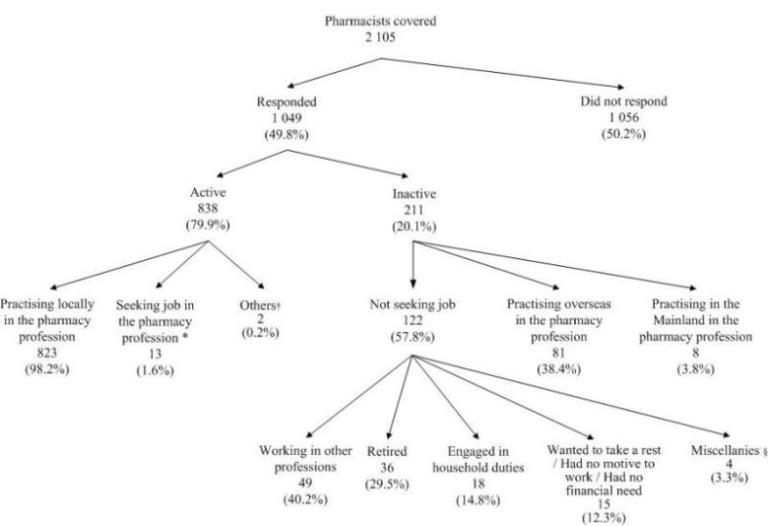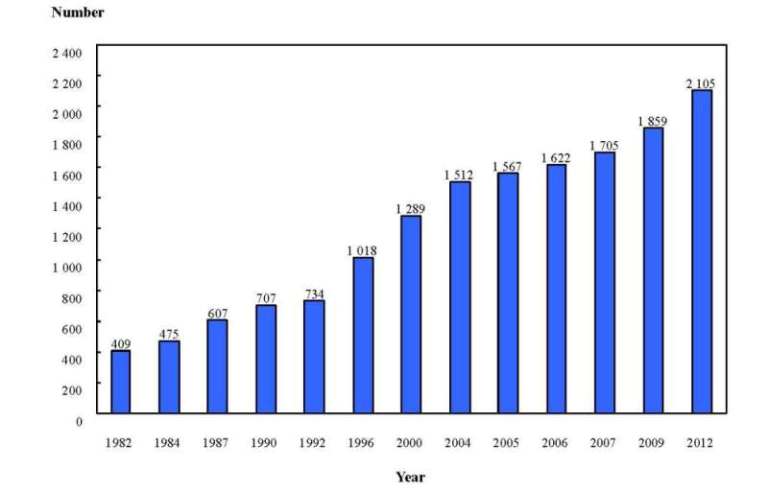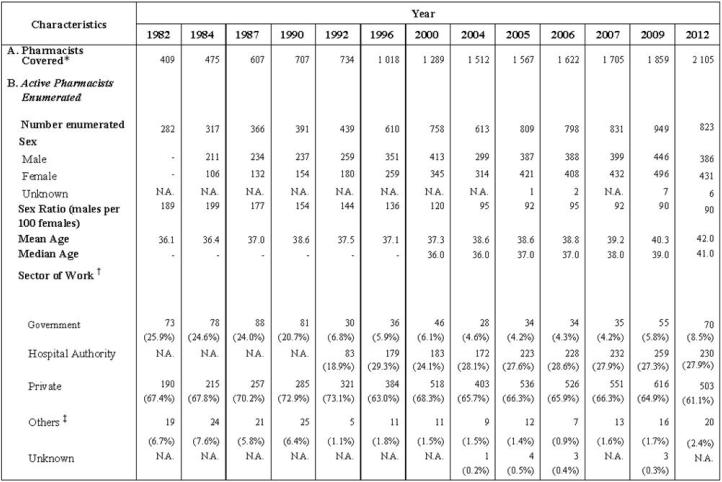Statistics
2012 Health Manpower Survey
Summary of the Characteristics of Pharmacists Enumerated
I. Pharmacists Covered
1.1 The pharmacists covered in the 2012 HMS were pharmacists registered with the Pharmacy and Poisons Board of Hong Kong under the Pharmacy and Poisons Ordinance (Chapter 138) as at the survey reference date - 31.8.2012.
1.2 The number of pharmacists covered was 2 105.
1.3 Of the 2 105 pharmacists covered, 1 049 responded to the survey, giving an overall response rate of 49.8%. Among the respondents, 838(79.9%) were economically active*† (active) in the local pharmacy profession as at 31.8.2012 and 211(20.1%) reported that they were economically inactive*‡ (inactive) in the local pharmacy profession (Chart A) .
1.4 Of the 838 active pharmacists enumerated, 13 were seeking jobs and two were starting business at subsequent date or waiting to take up a new job in the local pharmacy profession during the 30 days before the survey. The survey results presented in paragraph 1.6 below were based on the 823 responding pharmacists who were practising in the local pharmacy profession as at 31.8.2012. As some questionnaires items had missing responses, percentages presented below may not add up to 100%.
1.5 Of the 211 inactive pharmacists, 81 reported practising overseas, eight reported practising in the Mainland and 122 reported not seeking jobs in the pharmacy profession during the 30 days before the survey (Chart A) . Among the 122 inactive pharmacists who reported not seeking jobs, the main reasons reported for not seeking jobs included: 49 (40.2%) were working in other professions, 36 (29.5%) were retired, 18 (14.8%) were engaged in household duties and 15 (12.3%) wanted to take a rest / had no motive to work / had no financial need.
1.6 Six active pharmacists did not indicate sex. Of the remaining 817 active pharmacists enumerated who were practising in the local pharmacy profession, 386 (47.2%) were male and 431 (52.8%) were female, giving an overall sex ratio (males per 100 females) of 90. Apart from the seven pharmacists who did not indicate age, the median age of the remaining 816 active pharmacists enumerated was 41.0 years. The median age of the active female pharmacists enumerated was 37.0 years and that of their male counterparts was 45.0 years.
* In the survey, the criteria used in defining economically active / inactive followed those recommended by the International Labour Organization, which are also being used by the Census and Statistics Department in Hong Kong.
† "Economically active" pharmacists comprised all "employed" and "unemployed" pharmacists. "Employed" pharmacists referred to those pharmacists practising in the pharmacy profession in Hong Kong during the survey period, while "unemployed" pharmacists referred to those pharmacists who (a) were not practising in the local pharmacy profession during the survey period; (b) had been available for work during the seven days before the survey; and (c) had sought work in the local pharmacy profession during the 30 days before the survey.
‡ "Economically inactive" pharmacists comprised the pharmacists who were not practising in the pharmacy profession in Hong Kong during the survey period, excluding those who had been on leave during the survey period and who were "economically active" but "unemployed".
Chart A : Activity Status of Pharmacists Covered

| Notes﹕ | * | Figure refers to the number of responding pharmacists who (a) were not practising in the pharmacy profession in Hong Kong during the survey period; (b) had been available for work in the local pharmacy profession during the seven days before the survey; and (c) had sought work in the local pharmacy profession during the 30 days before the survey. |
| † | Figure refers to the number of responding pharmacists who (a) were not practising in the pharmacy profession in Hong Kong during the survey period; (b) had been available for work in the local pharmacy profession during the seven days before the survey; and (c) were starting business at subsequent date or waiting to take up a new job in the local pharmacy profession during the 30 days before the survey. | |
| § | Figure refers to the number of responding pharmacists who reported emigrated, undertaking study, etc. |
| Percentage may not add up to 100% due to rounding. |
1.7 The responding active pharmacists were requested to indicate the characteristics of their main jobs*. Distribution by sector for the main jobs showed that 61.1% were working in the private sector, followed by those working in the Hospital Authority (27.9%), the Government (8.5%) and the academic and subvented sectors (2.4%).
1.8 The median age of pharmacists enumerated was 44.0 years for those working in the private sector, followed by 37.0 years for those working academic and subvented sectors, 35.0 years in the government and 33.5 years in the Hospital Authority.
| * | Main jobs referred to the jobs in which the pharmacist had spent most of their working time. |
1.9 Of the 823 active pharmacists enumerated, 70.6% spent most of their working time on service in pharmacy*, followed by 13.2% on administration / management† and 7.4% on manufacturing / marketing / sales‡.
1.10 The median number of hours of work (excluding meal breaks) per week of the 823 active pharmacists enumerated was 44.0 hours. Among them, 99 (12.0%) were required to undertake on-call duty, with a median of 19.0 hours of on-call duty (excluding normal duty) per week.
1.11 Of the 823 active pharmacists enumerated, 84.8% held Bachelor’s Degree, 13.0% held Master’s Degree and 0.9% held Doctoral Degree as their basic qualifications.
1.12 Of the 823 active pharmacists enumerated, 514 (62.5%) received / were receiving additional training.
1.13 Of the 514 active pharmacists with additional training, 21 (4.1%) had not yet completed the additional training, 309 (60.1%) held Master’s Degree, 71 (13.8%) held Certificate, 29 (5.6%) held Diploma and 28 (5.4%) held Graduate Diploma as the highest qualification.
1.14 Among those pharmacists who received / were receiving additional training, some of them selected more than one field of additional training. The total number of count of active pharmacists who received / were receiving additional training was 636, in which 44.7% received / were receiving additional training in clinical pharmacy, 16.8% in Chinese medicine, 9.3% in pharmacy, 7.4% in health administration, 4.7% for each field in medical sciences and pharmaceutical science, 3.1% in pharmaceutical technology and 1.6% in chemical analysis.
1.15 Of the 514 active pharmacists enumerated who received / were receiving additional training, 411 (80.0%) received / were receiving additional training in one field of additional training. Among them, 54.3% were trained / receiving training in clinical pharmacy, 16.1% in Chinese medicine, 7.5% in pharmacy, 6.1% in health administration, 3.6% in both medical sciences and pharmaceutical science, and 1.2% in pharmaceutical technology.
1.16 Regarding continuing education training, 716 (87.0%) of the active pharmacists reported that they had participated in continuing education training in 2012, 104 (12.6%) did not participate in any continuing education training and three (0.4%) did not report whether they had participated in continuing education training or not. Among the 716 active pharmacists enumerated who had participated in continuing education training, the distribution of continuing education training hours attained in the past 12 months was: 1 to 10 hours (27.2%), 11 to 20 hours (25.1%), 21 to 30 hours (17.6%), 31 to 40 hours (9.4%) and more than 40 hours (20.7%).
| * | Service in pharmacy referred to the work which had direct contact with patients in dispensing and patient counselling. |
| † | Administration / Management referred to the work which was out of scope of pharmacy such as supervising staff, accounting, budget control, procurement of drugs, etc. |
| ‡ | Manufacturing / Marketing / Sales referred to the work involving in the pharmaceutical company (wholesaler) or pharmaceutical manufacturer such as manufacturing, marketing and sales. |
II. Trend Analysis
2.1 Comparison of findings of the 2012 HMS with those surveys before 2004 should be made with caution as the survey methodology and reference date had been changed.
2.2 A total of 2 105 pharmacists were covered in 2012 HMS, representing an increase of 39.2% over the 2004 HMS (1 512). Compared with the 1982 HMS, the number of pharmacists covered in the HMS recorded an average annual growth rate of 5.6% (Chart B) .
2.3 There was a decreasing proportion of male pharmacists. The overall sex ratio (males per 100 females) had shown a decrease from 199 in 1984 to 90 in 2012 (Table A) .
2.4 The median age of the active pharmacists enumerated increased gradually from 36.0 years in 2000 to 41.0 years in 2012 (Table A) .
2.5 From 1982 to 2012, the largest proportion of active pharmacists enumerated was working in the private sector, ranging from 61.1% to 73.1%. Prior to the establishment of the Hospital Authority in 1991, more than one-fifth of active pharmacists enumerated worked in the Government (20.7% to 25.9%); and the proportion decreased to less than 9% from 1992 onwards. The proportion in the Hospital Authority increased from 18.9% in 1992 to 27.9% in 2012 (Table A) .
Chart B : Number of Pharmacists Covered by Year (1982, 1984, 1987, 1990, 1992, 1996, 2000, 2004, 2005, 2006, 2007, 2009 and 2012)

| Note : | Figures of the year 2000 and before refer to the number of pharmacists registered with the Pharmacy and Poisons Board of Hong Kong as at 1st July of the respective years, whereas the figures of 2004 to 2007, 2009 and 2012 refer to that as at 31st August of the respective years. |
Table A : Selected Characteristics of Active Pharmacists Enumerated (1982, 1984, 1987, 1990, 1992, 1996, 2000, 2004, 2005, 2006, 2007, 2009 and 2012)

| Notes﹕ | * | Figures of the year 2000 and before refer to the number of pharmacists registered with the Pharmacy and Poisons Board of Hong Kong as at 1st July of the respective years, whereas the figures of 2004 to 2007, 2009and 2012 refer to the number of pharmacists registered with the Pharmacy and Poisons Board of Hong Kong as at 31st August of the respective years. |
| † | In 2004 to 2007, 2009 and 2012, the sector refers to the sector of main job. | |
| ‡ | Included academic and subvented sectors. Military was included in the 1987 HMS and 1996 HMSl. | |
| There may be slight discrepancy between the sum of individual items and the total due to rounding. | ||
| N.A. Not applicable | ||
| ‘-’ Not available |